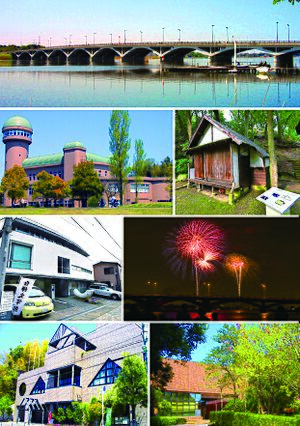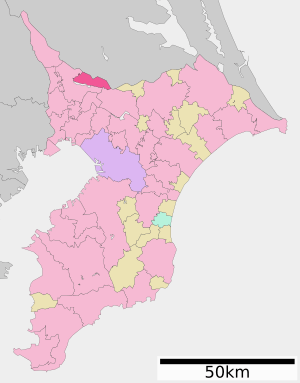Abiko, Chiba facts for kids
Quick facts for kids
Abiko
我孫子市
|
|||||||||||||
|---|---|---|---|---|---|---|---|---|---|---|---|---|---|

|
|||||||||||||
|
|||||||||||||

Location of Abiko in Chiba Prefecture
|
|||||||||||||
| Country | Japan | ||||||||||||
| Region | Kantō | ||||||||||||
| Prefecture | Chiba | ||||||||||||
| Area | |||||||||||||
| • Total | 43.19 km2 (16.68 sq mi) | ||||||||||||
| Elevation | 4 m (13 ft) | ||||||||||||
| Population
(February 2024)
|
|||||||||||||
| • Total | 131,183 | ||||||||||||
| • Density | 3,037.3/km2 (7,866.7/sq mi) | ||||||||||||
| Time zone | UTC+9 (Japan Standard Time) | ||||||||||||
| Postal code |
270-1192
|
||||||||||||
| Phone number | 04-7185-1111 | ||||||||||||
| Address | 1858 Banchi, Abiko-shi, Chiba-ken 270-1192 | ||||||||||||
| Climate | Cfa | ||||||||||||
|
|||||||||||||
Abiko (我孫子市, Abiko-shi) is a city located in Chiba Prefecture, Japan. As of February 2024, about 131,183 people live there in 62,193 homes. The city covers an area of 43.19 square kilometers (16.68 sq mi).
Contents
Exploring Abiko's Location and Surroundings
Abiko is in the northwestern part of Chiba prefecture. It is about 30 kilometers (19 mi) from Chiba, the capital city of the prefecture. Abiko is also close to central Tokyo, about 30 to 40 kilometers (19 to 25 mi) away.
The Tone River separates Abiko from Ibaraki Prefecture to the north. The city is on a flat area called the Shimosa Plateau. This area is about 20 meters (66 ft) above sea level. Abiko stretches about 14 kilometers (8.7 mi) from east to west. It is about 4 to 6 kilometers (2.5 to 3.7 mi) from north to south.
Cities and Towns Near Abiko
Abiko shares its borders with several other cities and towns.
- In Chiba Prefecture:
- In Ibaraki Prefecture:
* Toride * Tone
Abiko's Climate and Weather
Abiko has a humid subtropical climate. This means it has warm summers and cool winters. There is usually little to no snowfall.
The average temperature in Abiko is about 14.7 °C (58.5 °F) each year. The city gets about 1345 mm (53 in) of rain per year. September is usually the wettest month. August is the warmest month, with temperatures around 26.3 °C (79.3 °F). January is the coldest, with temperatures around 3.8 °C (38.8 °F).
Abiko's Growing Population
The number of people living in Abiko grew for a long time. Recently, the population has stayed about the same.
| Historical population | ||
|---|---|---|
| Year | Pop. | ±% |
| 1950 | 23,120 | — |
| 1960 | 27,063 | +17.1% |
| 1970 | 49,240 | +81.9% |
| 1980 | 101,061 | +105.2% |
| 1990 | 120,628 | +19.4% |
| 2000 | 127,733 | +5.9% |
| 2010 | 134,017 | +4.9% |
| 2020 | 130,510 | −2.6% |
A Look Back at Abiko's History
People have lived in the Abiko area for a very long time. Archaeologists have found stone tools from 30,000 years ago.
During the Edo period (1603-1868), Abiko was an important river port on the Tone River. It was also a post station on the Mito Kaidō. This was a major road connecting Edo (now Tokyo) with Mito.
After the Meiji Restoration in 1868, Abiko became a modern town. This happened on April 1, 1889. It joined with Fusa and Kohoku villages. Later, Abiko moved to a different district in 1897.
From the Taisho period (1912-1926) to the early Showa period (1926-1989), Abiko was a popular place for artists and writers. Many famous cultural figures, like Naoya Shiga and Saneatsu Mushanokoji, had homes there. It became a center for a group of writers called the Shirakabaha.
Abiko grew by adding nearby villages in 1954 and 1955. It officially became a city on July 1, 1970. In 2003, people voted against joining with the cities of Kashiwa and Shōnan. Some parts of Abiko were damaged by the 2011 Tōhoku earthquake and tsunami. This damage was caused by soil liquefaction, where the ground acts like a liquid during an earthquake.
Abiko's Economy and Jobs
Farming is still important in Abiko. However, the city is mostly a business hub for the region. Since the 1970s, Abiko has become a commuter town. This means many people who live in Abiko travel to work in nearby cities like Chiba and Tokyo. About 32.3% of workers travel to central Tokyo. Another 12.4% travel to Kashiwa City.
Learning and Education in Abiko
Abiko has many schools for students of all ages.
Universities in Abiko
- Chuo Gakuin University
- Kawamura Gakuen Women's University
Schools for Younger Students
The city government runs 13 public elementary schools. It also operates six public middle schools. The Chiba Prefectural Board of Education runs two public high schools. There are also two private high schools in Abiko. A special education school for students with disabilities is also operated by the prefecture.
Getting Around Abiko: Transportation
Abiko has good transportation links, especially by train and road.
Railway Lines
![]() JR East – Jōban Line
JR East – Jōban Line
- Abiko – Tennōdai
![]() JR East – Narita Line
JR East – Narita Line
- Abiko - Higashi-Abiko - Kohoku - Araki - Fusa
Major Highways
 National Route 6
National Route 6 National Route 294
National Route 294 National Route 356
National Route 356
Fun Places to Visit in Abiko
Abiko has several interesting places to explore.
- Akebonoyama Park
- Abiko City Museum of Birds
- Yamashina Institute for Ornithology
Famous People from Abiko
Many notable people have come from Abiko.
- Isao Aoki, professional golfer
- Makoto Kaneko, professional baseball player
- Hajime Meshiai, professional golfer
- Seiji Ebihara, professional golfer
- Muga Takewaki, actor
- Asuka Tono, Takarazuka musician (a type of Japanese musical theater)
- Morinosuke Chiwaki, founder of Japan Dental Association
- Ryo Takeuchi, filmmaker
See also
 In Spanish: Abiko (Chiba) para niños
In Spanish: Abiko (Chiba) para niños





